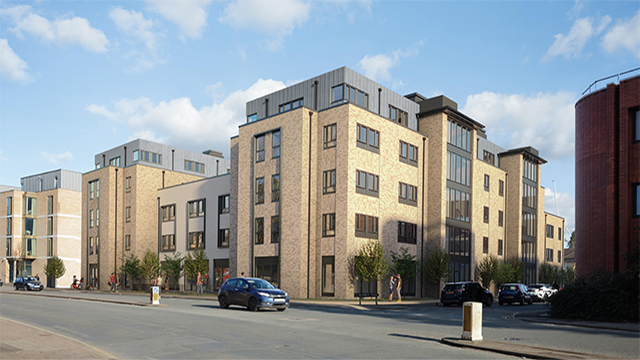Liz Peace to chair Old Oak and Park Royal
Former chief executive of the British Property Federation Liz Peace is to be appointed chair of the Old Oak and Park Royal Development Corporation in London.
She will be expected to help guide one of the largest regeneration projects in the country, which has the potential for 25,000 homes alongside millions of square feet of business space on its 1,600 acres spanning three boroughs.
She will also have to help navigate some of the problems that have arisen at the corporation, which is meant to guide planning and development, including delays in appointing a master planning team, overspend in its own planning department, and cuts to its budget.
Former chief executive of the British Property Federation Liz Peace is to be appointed chair of the Old Oak and Park Royal Development Corporation in London.
She will be expected to help guide one of the largest regeneration projects in the country, which has the potential for 25,000 homes alongside millions of square feet of business space on its 1,600 acres spanning three boroughs.
She will also have to help navigate some of the problems that have arisen at the corporation, which is meant to guide planning and development, including delays in appointing a master planning team, overspend in its own planning department, and cuts to its budget.
Peace retired from the BPF in 2014, and since taken on a number of advisory roles, including chairing the Curzon Regeneration Company in Birmingham, the Government Property Agency, and the government’s review of CIL.
It will be hoped she can use both her private and public sector knowledge to iron out any problems the scheme may face, though she has yet to be formally appointed.
The OPDC has been without a chair for the 10 months since deputy mayor Edward Lister stepped down in May 2016.
Chief executive of the OPDC Victoria Hills told the London Assembly budget monitoring sub-committee last week: “There is a bit of a recurrent theme through here that there are a number of decision points that require the leverage our chair will have.”
Alongside a 40% budget cut from the GLA, Transport for London, which is expected to contribute to the huge infrastructure investment and transport connections needed on the site, has removed funding for its side of the scheme in its business plan for 2017.
Doug Wilson, chief finance officer at the OPDC, said the intentions is to make the corporation self-funding. He said it is in discussions with the GLA to set up a model where it buys sites with funding that is essentially a loan from the GLA and with which it can generate a return in the longer time.
However, this will have to be balanced with new affordable housing requirements from any public land.
London’s largest regeneration opportunity
The OPDC was set up under former mayor Boris Johnson. It received formal approval from communities secretary Eric Pickles in April 2015. Its purpose is to oversee and drive development around the Crossrail and HS2 station set to open in 2026, and it has full planning powers within a 1,600-acre site covering parts of Hammersmith & Fulham, Ealing and Brent.
One of the first property-related decisions that mayor Sadiq Khan made after winning the mayoral election in May 2015 was to call in the organisation for review over concerns it was not providing enough affordable housing. He and deputy mayor James Murray have stated they want publicly owned sites to have a minimum of 50% affordable housing.
The review also looked into due diligence checks and memorandums of understanding agreed about the transfer of control on government land and the ownership of other land, again in relation to costs and affordable housing commitments.
Peace will need to help review the original MOU and the disposal of public land it refers to.
There will be discussions about who leads on land assembly at the site, which is in multiple public and private ownerships: the OPDC, the GLA, or the Homes for Londoners Board.
Hills said last week that it would be good for the corporation to have either a seat on the Homes for Londoners Board, or a member of that board as it chair. Peace was appointed last year.
Hills said the priorities going forward were:
Agreeing a clear funding, financing and commercial strategy, and “bolting down who is doing what”, which will be nailed down into a delivery strategy
Putting in place a sound planning framework in place
Appointing a master planning team – to keep OPDC’s involvement active in development
Ensuring the HS2 station design contract going out at the end of this year is future proofed
Ensuring a strong route into government
Developing a plan of improvement for Park Royal
“The ideal person for the job”
At 2pm on 10 April Liz Peace will appear before the appointments committee of the Greater London Authority at City Hall. The former chief executive of the British Property Federation will have her job as chair of the 1,600-acre Old Oak and Park Royal Development Corporation rubber-stamped by approving councillors. Her part-time appointment was announced by mayor Sadiq Khan on 30 March, writes Peter Bill.
“Liz is the ideal person for the job,” says a GLA insider of Peace. The 64-year-old former civil servant also chairs the Curzon Urban Regeneration Company in Birmingham and sits on the board of the Howard de Walden Estate and housebuilder Redrow. “She must emphasise her other commitments won’t get in the way,” said the source. “But, as an ex-civil servant, Liz will be brilliant at getting dosh out of the Treasury.”
“I am delighted to hear about the appointment of Liz Peace as Chair of the OPDC,” says architect Sir Terry Farrell, whose practice is one of seven contenders for the role of masterplanner, which is to be announced imminently. “This is very good news for London. Liz is a proven leader and action-oriented person who really understands the public and private sectors and how to get the best out of them.”
Last November, Khan said he had been “left a mess” by his predecessor, Boris Johnson. A critical report said £2.5bn of public money needs to be advanced to fund infrastructure, mainly to the semi-isolated 345-acre Old Oak section of the OPDC. Here a huge HS2 station is planned to open in 2026. Discussions with government departments about gap funding bill have so far proved fruitless.
“This is in the context of Ebbsfleet in Kent receiving £310m. And Birmingham has received £97m to extend its metro and enhance connections to and from the HS2 Curzon Street station. Birmingham is also benefitting from an expanded enterprise zone. The inequity of expecting London to shoulder the whole cost of infrastructure investment in the area should be pointed out to government in the strongest terms.”
Peace’s first task? “A business case should be put to HM Treasury for investment to enable growth. Her second task is also spelled out in the ‘mess’ report. Sort out the management. The board is dominated to its detriment by public servants talking to each other. Members include officials from Department for Transport, DCLG, Network Rail and HS2. Imagine what those meetings must be like.”
The OPDC was formed almost two years ago and planner Victoria Hills appointed chief executive. The former head of transport at the GLA has spent the past 24 months juggling the various ideas for the area and putting together the masterplan bid.
To send feedback, e-mail alex.peace@egi.co.uk or tweet @egalexpeace or @estatesgazette











